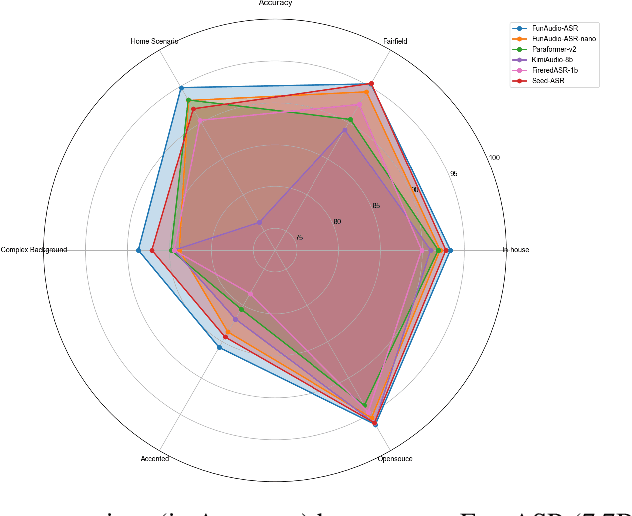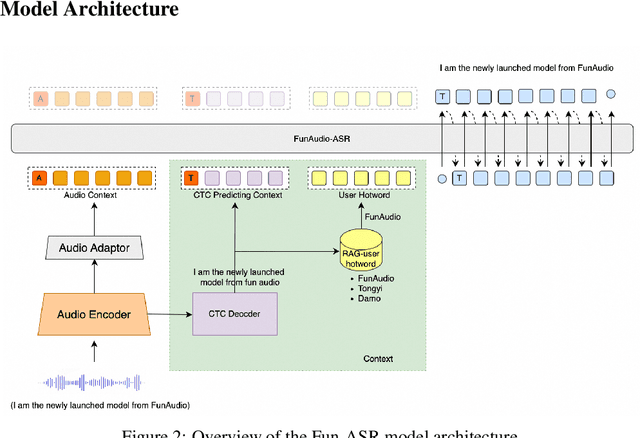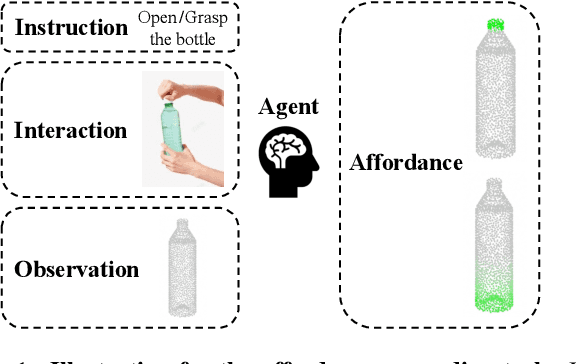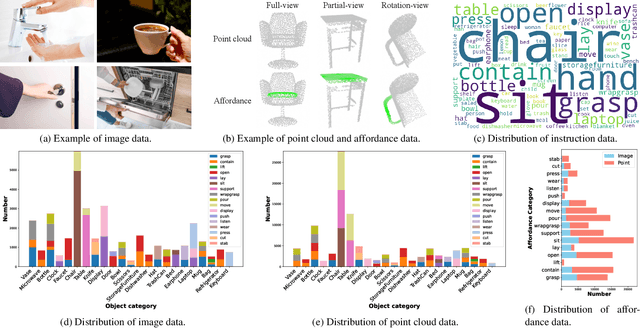Jieping Ye
University of Michigan, DiDi Chuxing
Interact-RAG: Reason and Interact with the Corpus, Beyond Black-Box Retrieval
Oct 31, 2025Abstract:Retrieval-Augmented Generation (RAG) has significantly enhanced LLMs by incorporating external information. However, prevailing agentic RAG approaches are constrained by a critical limitation: they treat the retrieval process as a black-box querying operation. This confines agents' actions to query issuing, hindering its ability to tackle complex information-seeking tasks. To address this, we introduce Interact-RAG, a new paradigm that elevates the LLM agent from a passive query issuer into an active manipulator of the retrieval process. We dismantle the black-box with a Corpus Interaction Engine, equipping the agent with a set of action primitives for fine-grained control over information retrieval. To further empower the agent on the entire RAG pipeline, we first develop a reasoning-enhanced workflow, which enables both zero-shot execution and the synthesis of interaction trajectories. We then leverage this synthetic data to train a fully autonomous end-to-end agent via Supervised Fine-Tuning (SFT), followed by refinement with Reinforcement Learning (RL). Extensive experiments across six benchmarks demonstrate that Interact-RAG significantly outperforms other advanced methods, validating the efficacy of our reasoning-interaction strategy.
FunAudio-ASR Technical Report
Sep 15, 2025



Abstract:In recent years, automatic speech recognition (ASR) has witnessed transformative advancements driven by three complementary paradigms: data scaling, model size scaling, and deep integration with large language models (LLMs). However, LLMs are prone to hallucination, which can significantly degrade user experience in real-world ASR applications. In this paper, we present FunAudio-ASR, a large-scale, LLM-based ASR system that synergistically combines massive data, large model capacity, LLM integration, and reinforcement learning to achieve state-of-the-art performance across diverse and complex speech recognition scenarios. Moreover, FunAudio-ASR is specifically optimized for practical deployment, with enhancements in streaming capability, noise robustness, code-switching, hotword customization, and satisfying other real-world application requirements. Experimental results show that while most LLM-based ASR systems achieve strong performance on open-source benchmarks, they often underperform on real industry evaluation sets. Thanks to production-oriented optimizations, FunAudio-ASR achieves SOTA performance on real application datasets, demonstrating its effectiveness and robustness in practical settings.
Enhancing Spatial Reasoning through Visual and Textual Thinking
Jul 28, 2025Abstract:The spatial reasoning task aims to reason about the spatial relationships in 2D and 3D space, which is a fundamental capability for Visual Question Answering (VQA) and robotics. Although vision language models (VLMs) have developed rapidly in recent years, they are still struggling with the spatial reasoning task. In this paper, we introduce a method that can enhance Spatial reasoning through Visual and Textual thinking Simultaneously (SpatialVTS). In the spatial visual thinking phase, our model is trained to generate location-related specific tokens of essential targets automatically. Not only are the objects mentioned in the problem addressed, but also the potential objects related to the reasoning are considered. During the spatial textual thinking phase, Our model conducts long-term thinking based on visual cues and dialogues, gradually inferring the answers to spatial reasoning problems. To effectively support the model's training, we perform manual corrections to the existing spatial reasoning dataset, eliminating numerous incorrect labels resulting from automatic annotation, restructuring the data input format to enhance generalization ability, and developing thinking processes with logical reasoning details. Without introducing additional information (such as masks or depth), our model's overall average level in several spatial understanding tasks has significantly improved compared with other models.
OmniDRCA: Parallel Speech-Text Foundation Model via Dual-Resolution Speech Representations and Contrastive Alignment
Jun 11, 2025Abstract:Recent studies on end-to-end speech generation with large language models (LLMs) have attracted significant community attention, with multiple works extending text-based LLMs to generate discrete speech tokens. Existing approaches primarily fall into two categories: (1) Methods that generate discrete speech tokens independently without incorporating them into the LLM's autoregressive process, resulting in text generation being unaware of concurrent speech synthesis. (2) Models that generate interleaved or parallel speech-text tokens through joint autoregressive modeling, enabling mutual modality awareness during generation. This paper presents OmniDRCA, a parallel speech-text foundation model based on joint autoregressive modeling, featuring dual-resolution speech representations and contrastive cross-modal alignment. Our approach processes speech and text representations in parallel while enhancing audio comprehension through contrastive alignment. Experimental results on Spoken Question Answering benchmarks demonstrate that OmniDRCA establishes new state-of-the-art (SOTA) performance among parallel joint speech-text modeling based foundation models, and achieves competitive performance compared to interleaved models. Additionally, we explore the potential of extending the framework to full-duplex conversational scenarios.
Consistent Paths Lead to Truth: Self-Rewarding Reinforcement Learning for LLM Reasoning
Jun 10, 2025Abstract:Recent advances of Reinforcement Learning (RL) have highlighted its potential in complex reasoning tasks, yet effective training often relies on external supervision, which limits the broader applicability. In this work, we propose a novel self-rewarding reinforcement learning framework to enhance Large Language Model (LLM) reasoning by leveraging the consistency of intermediate reasoning states across different reasoning trajectories. Our key insight is that correct responses often exhibit consistent trajectory patterns in terms of model likelihood: their intermediate reasoning states tend to converge toward their own final answers (high consistency) with minimal deviation toward other candidates (low volatility). Inspired by this observation, we introduce CoVo, an intrinsic reward mechanism that integrates Consistency and Volatility via a robust vector-space aggregation strategy, complemented by a curiosity bonus to promote diverse exploration. CoVo enables LLMs to perform RL in a self-rewarding manner, offering a scalable pathway for learning to reason without external supervision. Extensive experiments on diverse reasoning benchmarks show that CoVo achieves performance comparable to or even surpassing supervised RL. Our code is available at https://github.com/sastpg/CoVo.
Re-ranking Reasoning Context with Tree Search Makes Large Vision-Language Models Stronger
Jun 09, 2025Abstract:Recent advancements in Large Vision Language Models (LVLMs) have significantly improved performance in Visual Question Answering (VQA) tasks through multimodal Retrieval-Augmented Generation (RAG). However, existing methods still face challenges, such as the scarcity of knowledge with reasoning examples and erratic responses from retrieved knowledge. To address these issues, in this study, we propose a multimodal RAG framework, termed RCTS, which enhances LVLMs by constructing a Reasoning Context-enriched knowledge base and a Tree Search re-ranking method. Specifically, we introduce a self-consistent evaluation mechanism to enrich the knowledge base with intrinsic reasoning patterns. We further propose a Monte Carlo Tree Search with Heuristic Rewards (MCTS-HR) to prioritize the most relevant examples. This ensures that LVLMs can leverage high-quality contextual reasoning for better and more consistent responses. Extensive experiments demonstrate that our framework achieves state-of-the-art performance on multiple VQA datasets, significantly outperforming In-Context Learning (ICL) and Vanilla-RAG methods. It highlights the effectiveness of our knowledge base and re-ranking method in improving LVLMs. Our code is available at https://github.com/yannqi/RCTS-RAG.
CosyVoice 3: Towards In-the-wild Speech Generation via Scaling-up and Post-training
May 23, 2025Abstract:In our prior works, we introduced a scalable streaming speech synthesis model, CosyVoice 2, which integrates a large language model (LLM) and a chunk-aware flow matching (FM) model, and achieves low-latency bi-streaming speech synthesis and human-parity quality. Despite these advancements, CosyVoice 2 exhibits limitations in language coverage, domain diversity, data volume, text formats, and post-training techniques. In this paper, we present CosyVoice 3, an improved model designed for zero-shot multilingual speech synthesis in the wild, surpassing its predecessor in content consistency, speaker similarity, and prosody naturalness. Key features of CosyVoice 3 include: 1) A novel speech tokenizer to improve prosody naturalness, developed via supervised multi-task training, including automatic speech recognition, speech emotion recognition, language identification, audio event detection, and speaker analysis. 2) A new differentiable reward model for post-training applicable not only to CosyVoice 3 but also to other LLM-based speech synthesis models. 3) Dataset Size Scaling: Training data is expanded from ten thousand hours to one million hours, encompassing 9 languages and 18 Chinese dialects across various domains and text formats. 4) Model Size Scaling: Model parameters are increased from 0.5 billion to 1.5 billion, resulting in enhanced performance on our multilingual benchmark due to the larger model capacity. These advancements contribute significantly to the progress of speech synthesis in the wild. We encourage readers to listen to the demo at https://funaudiollm.github.io/cosyvoice3.
Leveraging Submodule Linearity Enhances Task Arithmetic Performance in LLMs
Apr 15, 2025



Abstract:Task arithmetic is a straightforward yet highly effective strategy for model merging, enabling the resultant model to exhibit multi-task capabilities. Recent research indicates that models demonstrating linearity enhance the performance of task arithmetic. In contrast to existing methods that rely on the global linearization of the model, we argue that this linearity already exists within the model's submodules. In particular, we present a statistical analysis and show that submodules (e.g., layers, self-attentions, and MLPs) exhibit significantly higher linearity than the overall model. Based on these findings, we propose an innovative model merging strategy that independently merges these submodules. Especially, we derive a closed-form solution for optimal merging weights grounded in the linear properties of these submodules. Experimental results demonstrate that our method consistently outperforms the standard task arithmetic approach and other established baselines across different model scales and various tasks. This result highlights the benefits of leveraging the linearity of submodules and provides a new perspective for exploring solutions for effective and practical multi-task model merging.
Grounding 3D Object Affordance with Language Instructions, Visual Observations and Interactions
Apr 07, 2025



Abstract:Grounding 3D object affordance is a task that locates objects in 3D space where they can be manipulated, which links perception and action for embodied intelligence. For example, for an intelligent robot, it is necessary to accurately ground the affordance of an object and grasp it according to human instructions. In this paper, we introduce a novel task that grounds 3D object affordance based on language instructions, visual observations and interactions, which is inspired by cognitive science. We collect an Affordance Grounding dataset with Points, Images and Language instructions (AGPIL) to support the proposed task. In the 3D physical world, due to observation orientation, object rotation, or spatial occlusion, we can only get a partial observation of the object. So this dataset includes affordance estimations of objects from full-view, partial-view, and rotation-view perspectives. To accomplish this task, we propose LMAffordance3D, the first multi-modal, language-guided 3D affordance grounding network, which applies a vision-language model to fuse 2D and 3D spatial features with semantic features. Comprehensive experiments on AGPIL demonstrate the effectiveness and superiority of our method on this task, even in unseen experimental settings. Our project is available at https://sites.google.com/view/lmaffordance3d.
Improving Complex Reasoning with Dynamic Prompt Corruption: A soft prompt Optimization Approach
Mar 17, 2025



Abstract:Prompt-tuning (PT) for large language models (LLMs) can facilitate the performance on various conventional NLP tasks with significantly fewer trainable parameters. However, our investigation reveals that PT provides limited improvement and may even degrade the primitive performance of LLMs on complex reasoning tasks. Such a phenomenon suggests that soft prompts can positively impact certain instances while negatively affecting others, particularly during the later phases of reasoning. To address these challenges, We first identify an information accumulation within the soft prompts. Through detailed analysis, we demonstrate that this phenomenon is often accompanied by erroneous information flow patterns in the deeper layers of the model, which ultimately lead to incorrect reasoning outcomes. we propose a novel method called \textbf{D}ynamic \textbf{P}rompt \textbf{C}orruption (DPC) to take better advantage of soft prompts in complex reasoning tasks, which dynamically adjusts the influence of soft prompts based on their impact on the reasoning process. Specifically, DPC consists of two stages: Dynamic Trigger and Dynamic Corruption. First, Dynamic Trigger measures the impact of soft prompts, identifying whether beneficial or detrimental. Then, Dynamic Corruption mitigates the negative effects of soft prompts by selectively masking key tokens that interfere with the reasoning process. We validate the proposed approach through extensive experiments on various LLMs and reasoning tasks, including GSM8K, MATH, and AQuA. Experimental results demonstrate that DPC can consistently enhance the performance of PT, achieving 4\%-8\% accuracy gains compared to vanilla prompt tuning, highlighting the effectiveness of our approach and its potential to enhance complex reasoning in LLMs.
 Add to Chrome
Add to Chrome Add to Firefox
Add to Firefox Add to Edge
Add to Edge